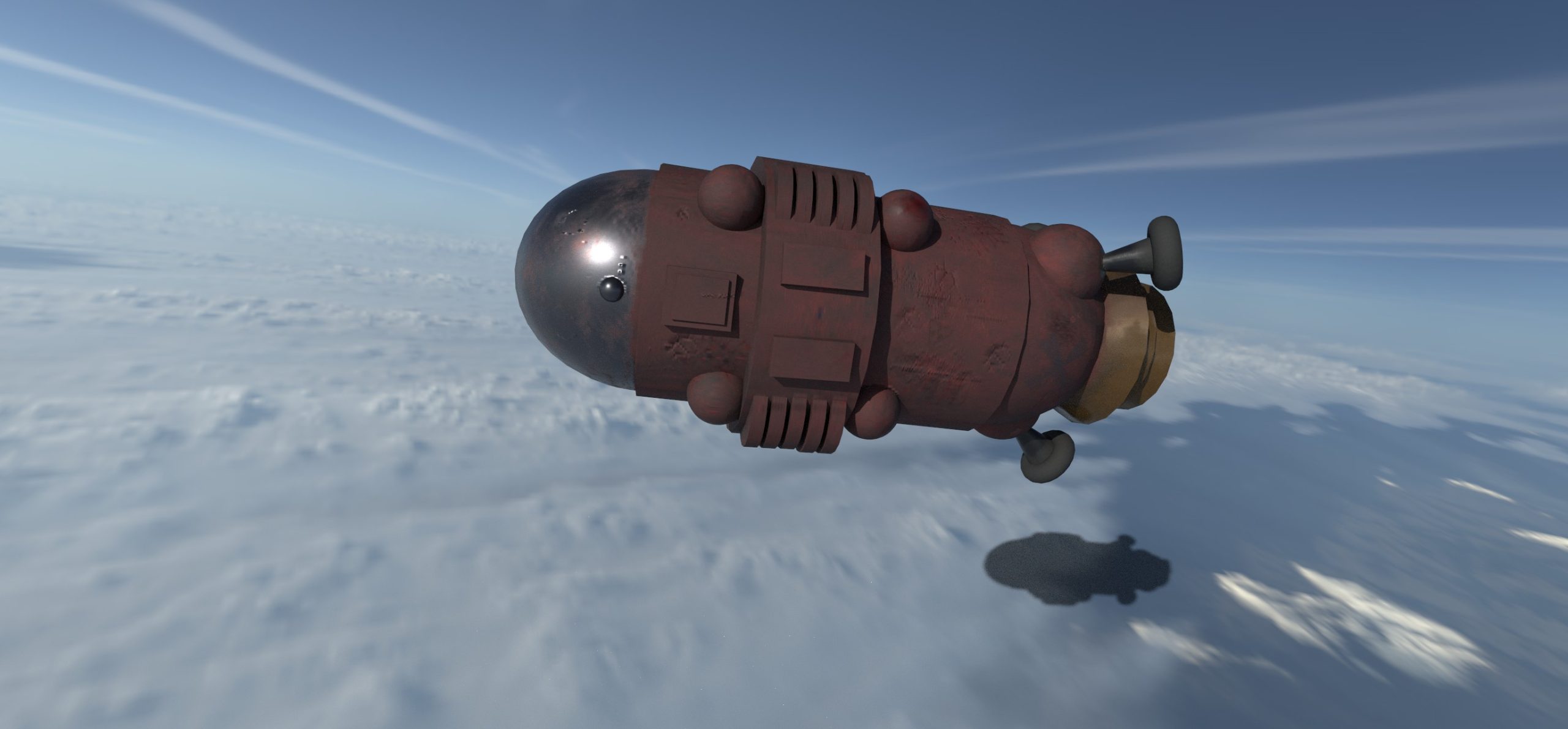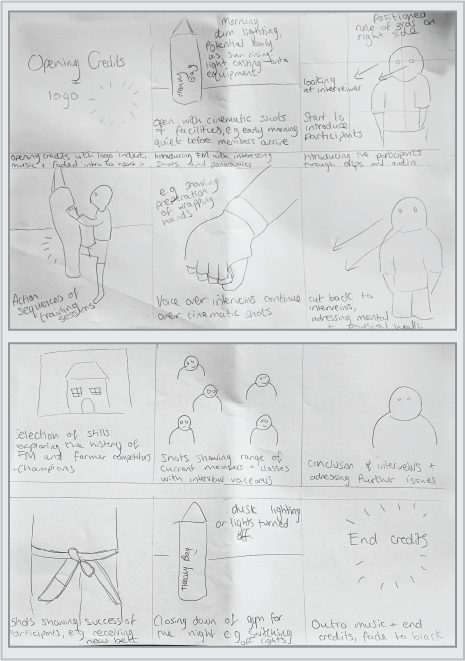Fight Ministry Short Documentary Film
Exploring the Physical and Mental Health Benefits of Participating in a Combat Sport
Introduction
The development process of creating the documentary explored many issues and provided a unique and intimate view into the experiences of individuals training in a martial art at a local community gym; Fight Ministry Hull. The film uses a mixture of interviews, training footage, and cinematic shots to create a visual experience of everyday activities, memories, and experiences within the community gym.
Logo Design Part One – Adobe Illustrator
The logo was designed to be minimalistic but also suggestive by the use of iconography to let the viewer know what the brand is. Basic keyboard symbols and letters were used in a sans-serif font to create a bold and striking outline. The logo signifies a camera pointing at the viewer, with the lens displaying the initials of the director; (Caroline Arnott) CA. This concept seeks to engage the user with a direct and effective graphic message that is simplistic but direct.
After consideration it was decided that the text ‘Caroline Arnott Studios’ would be added to the logo, this provides the user with a clear message of the name and type of service provided by the company. Many variations of colour and background were experimented with, but the simplistic minimalistic design was the final choice due to the nature of it being visually easy to understand.


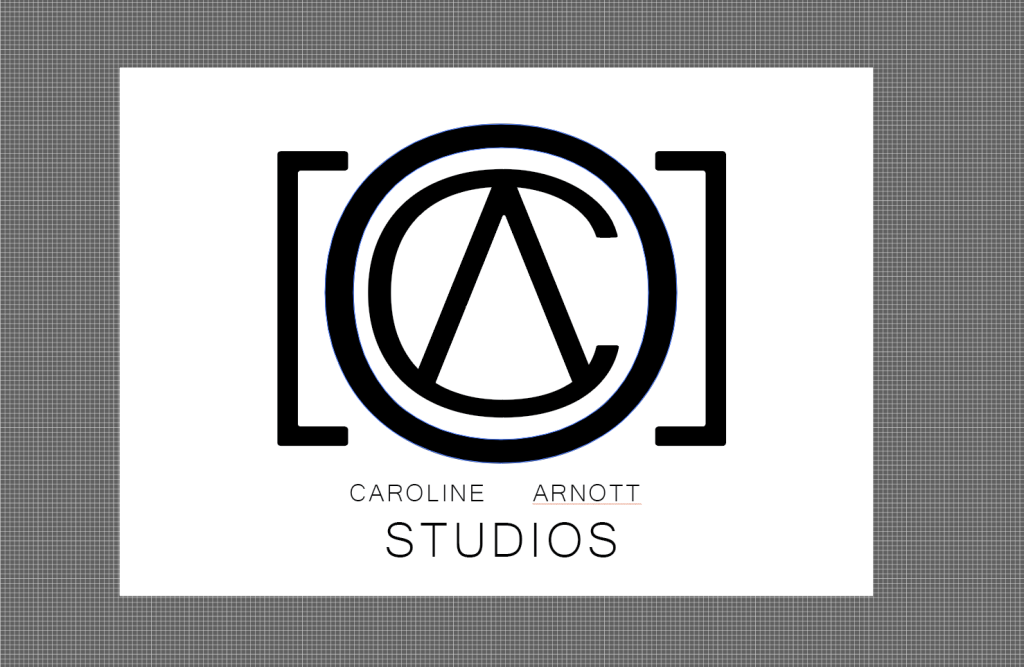
Logo Design Part Two – Adobe After Effects
The 2D logo created in Adobe Illustrator was then improved in After Effects.
The design was improved to a 3D version to create a logo that would enhance the effectiveness of the graphic logo message, in this logo the design is changed to a 3D shape which then follows a path to give the impression that the logo is being drawn. This is also more visually aesthetic to the viewer compared to the 2D design, the logo suggests professionalism and would also be accompanied by a unique audio attachment to provide optimum engagement to the viewer.
When observing the different options used to create the logo, many components make up the finished 3D piece, some subtle thing to note would be a navy blue drop shadow, this is to give the logo more depth and a more realistic 3D immersive experience.
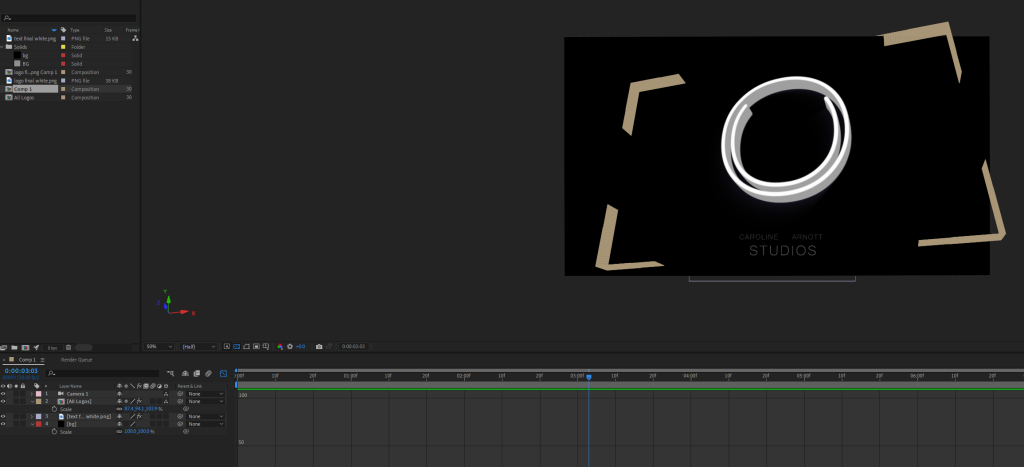

The finished animated logo can be viewed below, the audio indent has not been added yet as another student collaborator is working on this project, this student is in the process of making an audible indent to be used with the logo in the final piece.
Aims (Revisited)
- To create a documentary documenting the benefits of taking part in a mixed martial arts or fitness activity at a community gym
- Explore the benefits of the physical health of participants
- Explore the benefits of the psychological health of participants
- Explore the social benefits of participants
- Explore the possibility of forming alliances with community agencies or GPs to prescribe exercise as an alternative or aid to treat mental illnesses
- Explore the marketing benefits for the gym as a result of producing the documentary
Workflow Considerations
The Gantt Chart below required some adjustments to the predicted timeline, some tasks did require a longer duration, and the planning of the filming did take a longer duration than initially planned which would be accounted for on the live chart and adjusted accordingly. Due to unforeseen circumstances some of the interviewees could not participate on the planned dates, which further extended the length of time taken to complete filming, this was adjusted accordingly on the chart.

Design Process – Story Board Reflection
The Storyboard served as the starting point for planning out the main scenes to be captured during the filming process. Since making this storyboard, the narrative of the documentary evolved and changed to be more in-depth and informative of a select few individuals. The filming was conducted over a number of months, with planned interviews as well as candid shots and cinematics captured which improved the overall visual and audible design of the documentary.
A selection of the scenes that were planned in the storyboard can be viewed below, the storyboard served as an initial plan for the film, with some ideas being expanded upon and explored further.





Location Observation and Planning (Revisited)
The initial ideas in the proposal for the position of the participant were changed slightly. The revised position features the participant positioned towards the back of the room, this enabled the capture of one of the iconography logos associated with the gym ‘Slaughterhouse Hull.’ This was the original name of the gym which existed at another location over 10 years ago and is a reminder to the gym members of the history of the gym’s roots.

There is access to a door that allows natural light from the right-hand side, this was because the room’s artificial lighting and red mats provided a red hue which was adjusted in post-production although not completely removed. In the interview below the participant is lit from the left side with natural lighting, therefore the participant recorded in more natural light compared to the original interview position.
The interview was recorded with a shallow depth of field which is used to highlight and create focus on the participant, in addition, the blurred background reduces distraction from exterior factors to the viewer, so they can focus solely on the participant and their interview.
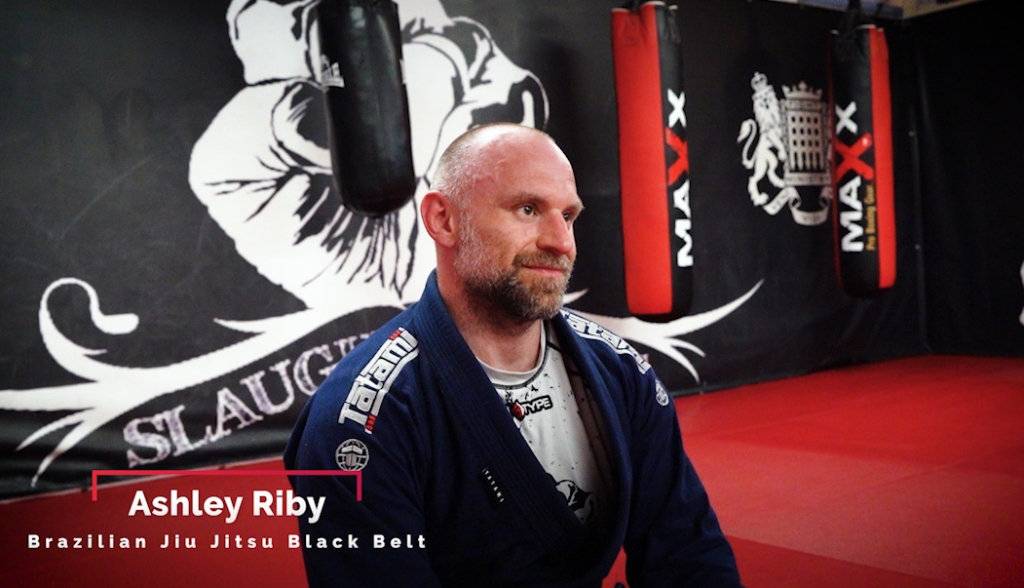
Interviews
The participants were all asked a pre-agreed list of interview questions, some of which can be noted below;
- Name and age
- Length of time trained in preferred combat sport and what level
- Describe their first experience when entering the gym
- Discuss the personal experiences of being in lockdown during Covid and the physical and mental health effects of that
- Would you recommend training in a combat sport
- Will you keep training in the future
This basic list was expanded on using probing interview questions to provide the participant to further explore and share their personal and intimate issues and success stories whilst training at the gym.
The purpose of these interviews provide a deeper understanding of the effects of participating in a combat sport from a variety of individuals’ points of view, this can be demonstrated in the final piece as each participant has different and revealing insights into their personal experiences. This enhances the final documentary as it gives the viewer a much deeper understanding of the importance of exercise, community, friendship, and comradery within Fight Ministry.
Exploring the participant’s individual experiences will create a sense of connection for the wider community through shared experiences, the documentary can be used as a source of entertainment, education, and advertising for different sponsors and marketing companies.

A point to make when thinking about interview consistency would be to mark the location of the camera and tripod to record the same positioning, this was however adjusted due to the different individual sizes and movements, for example, Paul Regan has a different posture to Mike Patterson, so the adjustment in camera positioning was adjusted to accommodate their different movements during the interviews.

The interview is clipped with different relevant sparring and coaching footage which is unique to each participant, for example, Mike Patterson’s interviews have lots of clips displaying his different positions in the gym, firstly as a coach, a sparring partner, a friend, and a member of a community.

The interviews are cut with different action shots to keep the viewers engaged but also to visually enhance the participant’s stories, it provides insights into their roles and relationships within the gym environment. The action shots also align with some of the things that the participant discusses, for example, if they mention boxing, it will cut to a clip of gym members boxing, which creates a visual storyline to view in correlation to some of the topics discussed in the interviews. Another example would be when the participant above (Mike Patterson) discusses the difference between gym members before a class (dry t-shirt) to after training (wet t-shirt) which then shows a clip of him training after a full session in a wet t-shirt. these visual indicators allow the user to follow the personal storyline of the participant by providing visual cues and confirmation of the topics discussed. It could be used to create trust and ease in the viewer as the topics discussed are then backed up with visual evidence of key points made by the participant.
Equipment Used
Referring back to the proposal, some adjustments were made to the amount of equipment used, the revised shorter list below provided a more personal and candid approach to documenting different scenes and capturing insightful footage. The camera is compact and light meaning it can be used to record the natural interactions of the participants and gym members to provide a personal and in-depth experience of the day-to-day experiences at Fight Ministry.
The equipment used to film and record audio is listed below
- Sony A7 camera MK III
- Rode Video Mic Go
- Manfrotto tripod
For future improvements to create a higher production value, the use of multiple cameras when interviewing could be used, however, the use of a single small camera and the microphone was less invasive and obvious to the participant, meaning their interviews and responses were more natural and relaxed, compared to a full studio set up with multiple cameras and lights.
Another addition to improving the production value would be to include drone footage which would capture the exterior of the gym and its unique location just outside of the town centre of Hull, it would highlight to local viewers the location of the gym and display its iconic aesthetic, and create intrigue to the interior of the building.
As seen in the photo above, The Fight Ministry gym’s urban exterior in a drone shot would improve the viewer’s understanding of the community gym and the need for funding and development, this could be a visual advertisement to potential sponsors on some of the essential repair and maintenance work required to keep the gym running.
Colour Theory Principles
When referring to Tufte’s five design theories regarding colour theory, the use of colour can be used to understand how subtle variations of values can be used to convey information and influence a particular mood and aesthetic. With the Fight Ministry film, there is a very bold and noticeable use of red, blue, and black in the film, this can create different atmospheres and moods for the different training rooms which will be explored further below.
The interviews feature a side profile of the participant, this creates a candid aesthetic for the viewer and also provides an intimate and alternative perspective of the boxing ring and MMA cage. The participant is introduced in the lower third with a graphic stating their name and position at the gym. The red square which contains the text was used to highlight the text and also matches the colour palette of the gym, where red is a predominant colour used on the mats and painted on the walls. It sets the graphic standard which will be followed throughout the rest of the film when introducing other participants and the different martial arts being practiced.
The opening scenes display the main training top floor room of the gym, with its iconic metal roof beams, boxing ring, cage, and mats. This first scene introduces the viewer to a quiet, calm, and empty gym room before the classes begin, a vignette effect draws the viewer into the main focus scene of the documentary.
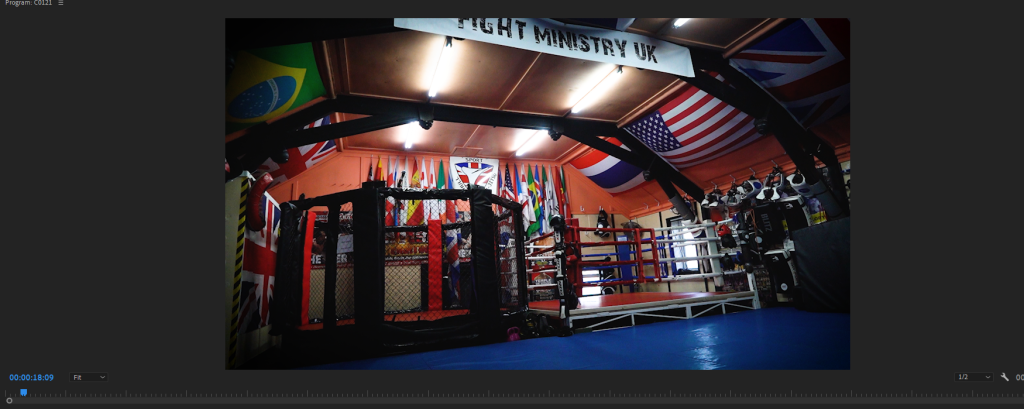
The two main rooms of the gym which feature in the film each have a different aesthetic, the top room which hosts the striking classes has the iconic roof beams with flags, a boxing ring, and an MMA cage, this room has a more industrial and brutalist aesthetic with contrasting bold colours, therefore all clips recorded will portray this gritty and unique training environment. There is a mixture of bold colours in this room, however, the blue training mats and access to more natural light do provide a cooler and differentiating aesthetic.
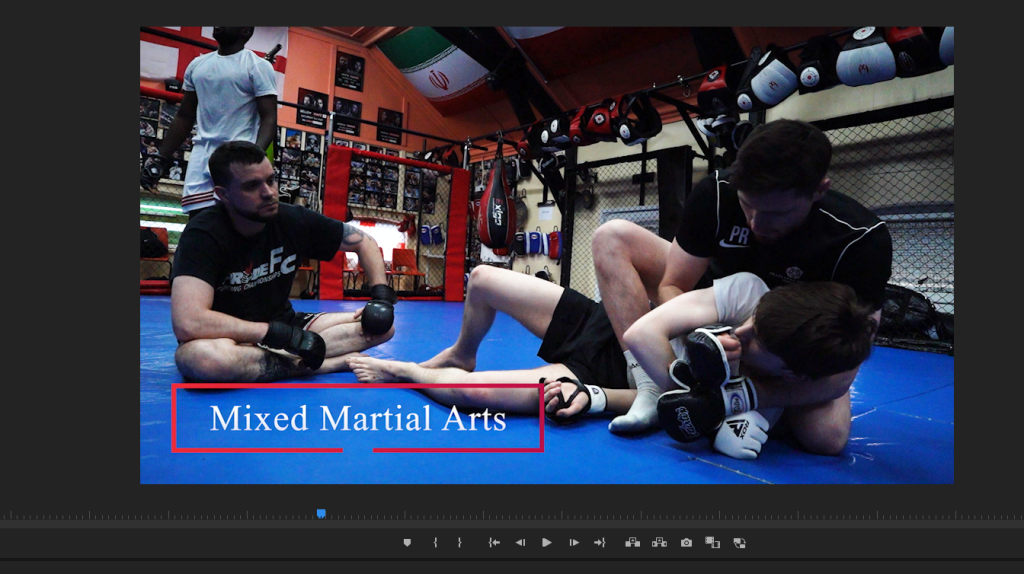
The second training room is predominantly red which gives off a warmer hue which is reflected on the face of the participant and background, among participants it is referred to as ‘The Red Room.’ This room hosts the Brazilian jiu-jitsu classes which are not striking focused, it is quoted as more of a ‘gentle art,’ therefore footage recorded in this room will not be as high intensity in comparison to the striking clips, this will be highlighted in the final film as the ‘Red Room’ footage will have a softer and warmer color hue to display this change in sequence.

The position of the participant also states the difference between the two rooms, to highlight a change in colour and room atmosphere. Paul Regan faces towards the right and Ashley Riby faces towards the right, this is a subtle suggestion to the viewer of a change of scene within the gym.
Soundtrack (With Student Collaboration)
A fellow student (Abiel Malfa) collaborated on this documentary by producing a selection of original audio tracks. The genre of this was designed to be engaging and complimentary to the visual experience. The task was to create three tracks, one for the introduction logo indent and then two tracks for the action sequences. In the end, a track was assigned to each participant, giving an audible indication of the change of interviewee and martial art being trained in. For example, the Muay Thai section has its soundtrack, as do all of the other martial arts displayed in the film. The clips recorded in the main room for striking (boxing rind and MMA cage) will have a more intense and dramatic audio accompaniment to accentuate the high-intensity action footage. In contrast to this, clips recorded in the downstairs ‘red room’ used for Brazilian jiu-jitsu will have a more relaxed and low-fi sound, which complements the calmer and more technical type of combat sport being displayed.
Both tracks created by the collaborating student can be previewed below, the student was provided with examples of music genres that would best accompany the type of footage recorded. Because the majority of the footage would be action footage this resulted in the accompanying audio tracks being dramatic and energizing. This creates an overall experience for the viewer when watching the film which is visually and audibly captivating due to both video and audio working together in synchronicity to deliver the stories and personal experiences of the participants.
The track ‘M1llionz Type Beat’ by Abiel Malfa will be used for the introduction sequences of the documentary, this more ambient yet still gritty and urban soundtrack will accompany the opening scenes of the cinematic shots showing the gym facilities and training rooms, when the beat becomes more dynamic and louder this will cut to high-intensity action sequences and compliment these scenes.
The second track ‘Pink Pantheress’ by Abiel Malfa has a more playful and upbeat theme, this track will be used to highlight the lower intensity scenes and emotions, such as laughter, community, and friendship which is a topic explored during the interviews and candid recordings or different participants.
A selection of other artists were used for the soundtrack, each participant has their own track, which is an audible signal to the audience of a change.

Design Process – (Audio Correction) Adobe Audition
The original sound recorded for the interviews were edited on Adobe Audition, the main focus was to use the De-esser setting to reduce any harshness of the participants voices, the low voice de-esser was used on the males and the high voice de-esser filter was used on the female participants. A noise reduction filter reduced any background hissing and humming noises picked up by the microphone, and finally a de-reverb helped to reduced background echo from the audio files. The edited audio is now clearer and with less background noise and interruptions.

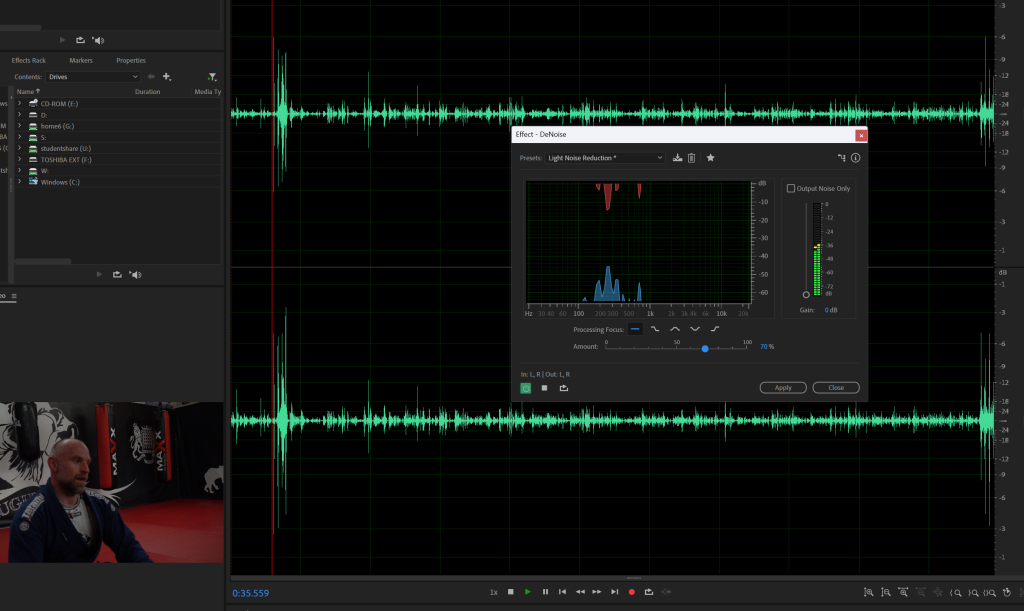
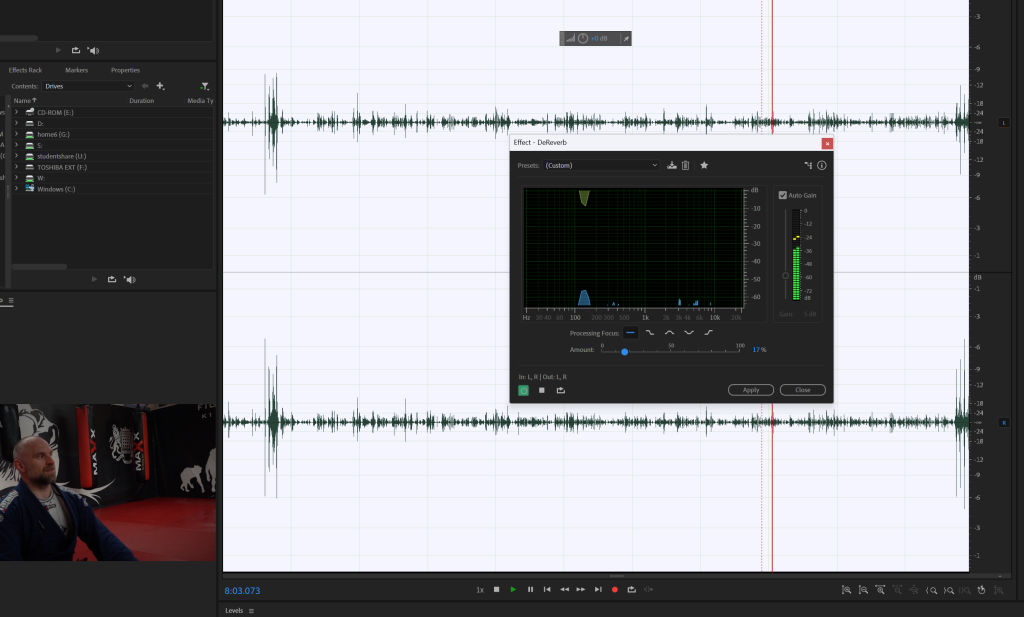

Design Process (Video Editing) – Adobe Premier Pro
The film opens with the Fight Ministry logo, which is edited with a glitch effect that introduces the viewer to the raw and gritty aesthetic of the documentary they are about to view, the style of the effect gives an immediate impression and indication of the documentary and its content. This is accompanied by audio which communicates immediately with the audience and aims to evoke feelings of interest, and intrigue and hopefully open them up to an emotional response so that they will feel a connection and a deeper understanding of some of the issues discussed in the film.
As can be viewed in the screenshot below, the process of editing in Adobe Premier Pro used a variety of graphic 2D and 3D design work in the initial introduction logos, as well as 2D graphics in the lower third of the footage which is used to inform the viewer of the type of martial art being captured, as well as to identify the participant. The video and audio recorded which has been clipped and organized in a way that tells an easy-to-follow story, follows the participants through their daily gym rituals which is clipped with accompanying action footage.

An explanation was added to signify a change in combat sport and also explain to the general veiwer what the key principals of the combat sport are, this seeks to be informative and educational, and assumes that the veiwer does not already have knowledge of the different types of martial arts. This means the film can be veiwed by a wider audience as they are informed and updated throughout the film on the various types of combat sports and their benefits.

The use of subtitles allows the viewer to fully understand the language and key points made by the participants during their interviews. The subtitles provide further accessibility for viewers, taking into consideration accessibility issues, one key point that participants highlighted is that they have a regional dialect which could potentially be difficult to understand for some viewers. By adding subtitles it allows a more thorough and complete understanding of the topics which the participant discusses. These subtitles are optional on Youtube where the video is uploded.
The subtitles will allow for the documentary to be viewed and displayed in different environments, the film has the potential to be used for advertising and marketing to a wider audience and therefore has a greater potential to reach people who would benefit from training a martial art. For example, this could be used in a GP’s waiting room, which links back to the original aims highlighted in the proposal, of potentially prescribing exercise as a treatment for depression and anxiety.
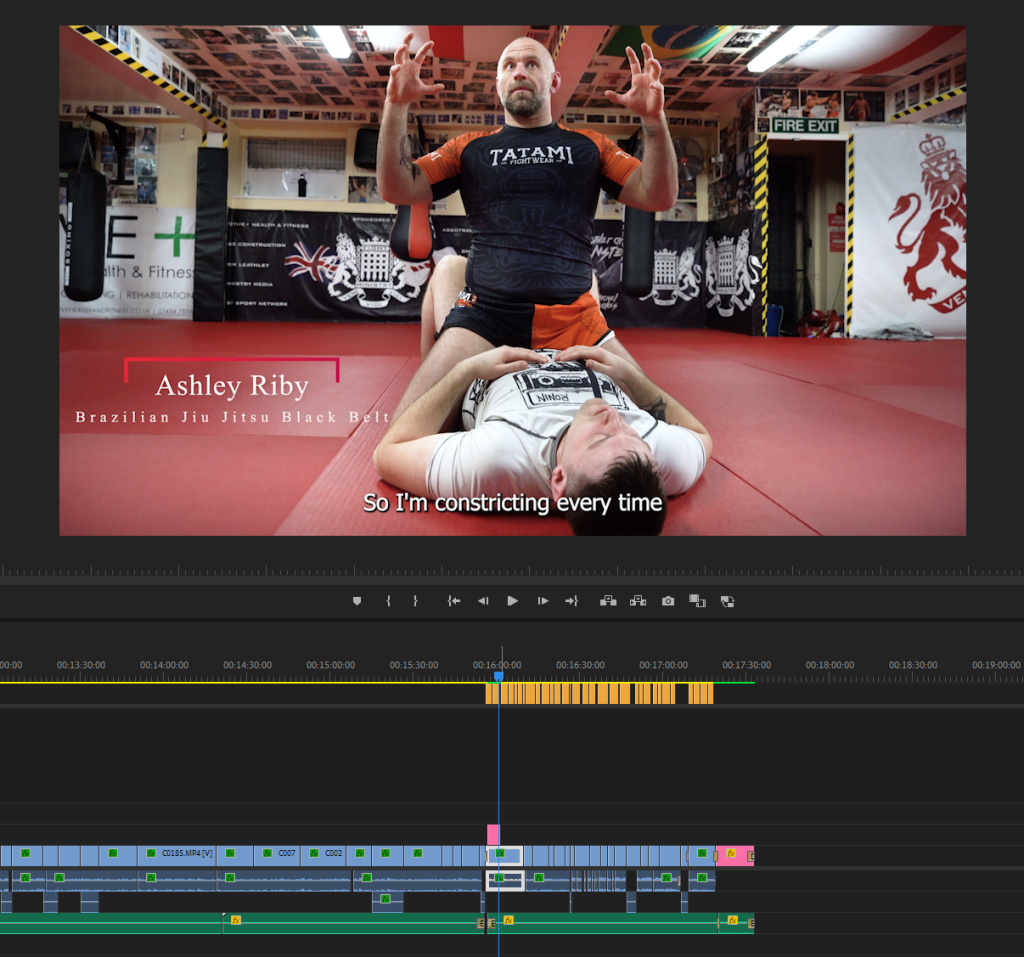
Interveiw Results (Mental and Physical Health Findings)
Each participant had various views and anecdotal evidence to support the idea that participating in a combat sport has positive mental and physical health benefits, some more notable mentions are listed below which support some of the claims made in the proposal.
Mel Leathley
- Important for people to have a safe space to let off steam in a controlled environment
- The importance for women to improve physical and mental health through combat sport
- The effects of isolation and financial struggles during Covid with considerations of closing the gym
- Realised during the pandemic how important it was for people to train for mental, physical and social benefits
Mike Patterson
- On falling in love with Thai Boxing
- Students before class versus after a class physical and mental observations
- Being aggressive in a friendly and competitive way enables strong bonds to be built
- Physical – increased strength, mobility and cardio
- Mental – being comfortable in uncomfortable environments
Paul Regan
- Competing and discussing different belts obtained through kickboxing
- Physical – Releasing endorphins and improving fitness
- Mental – The detrimental effects of being trapped away during Covid and the damage caused to people, overcoming social anxiety through martial arts, the confidence gained through combat sports
- The importance of helping other people through their struggles from coaching MMA
Ashley Riby
- Mental – Being able to manage emotions better from dealing with stress through training, addressing eating disorder from training which encourages healthier eating, the ability to trust and form strong bonds through jiu jitsu, how a combat sport can be meditative
- Physical – Improving general fitness and confidence
- The importance of women training and how it benefits them
Corrina Shore
- Mental – How combat sport can clear and switch off your mind in the moment, evoking a fight or flight release to reduce stress
- Physical – The difficulty of the sport and an overall full body workout benefits
- Learning to trust training partners and the bonds and camaraderie built through training
- The negative effects of not being able to train during Covid
- Being confident at work and in public knowing how to defend herself
- The importance of being humbled by learning a combat sport, being able to fail and be humble and not giving up
- The importance of her son seeing her train and showing him this is how to deal with stress for her
Future Considerations
There are further improvements to the film, which could be included to provide a more in-depth understanding of the services provided to the wider community, this could be in the form of future ‘episodes’ or to extend the current documentary, some ideas are explored below;
Fight Ministry History
This would explore the history and present competitors of the gym and explore the relationship with some of the former and current champions who are competing, most notably the current Bare Knuckle Champion Tony Shelids, and also George ‘The Saint’ Staines who trained at the gym from an early age and now competes professionally with the Oktagon fight promotion.
Episodes
Many different classes are not displayed in the documentary which is also very popular, including kids classes, K1 (kickboxing), karate, ladies’ striking, and the weights room. The production of short episodes would provide a brief introduction to these sessions and could be used for advertising on social media and for sponsors to use in advertising. Also, the production of longer episodes which would feature only one participant would provide more opportunity to further explore some of the topics that were highlighted in the film, for example for Chelsea May, a short episode could feature her with the ladies striking class and focus on the growing ladies classes and the reasons for this. For ethical purposes during this film, there was no recording of children in any of the classes, however, this could be a possibility with full consent from adults and individuals involved.
Extended Interviewee Participation
This could follow participants down various routes outside the gym, such as documenting competitions and showcasing other local gyms that have different inter-club competitions. The interviewees could be revisited to track their progress and interviewed again after some time, this would provide more anecdotal evidence to support the theory that participating in a combat sport provides physical and mental health benefits.
Funding and Endorsements
The potential to obtain funding from medical professionals would add validation to the claims that exercise and participating in a combat sport can provide physical and mental health benefits, there could be potential to access funding from different organizations to further explore and investigate this in the future.
References
Online – Tufte’s Five Design Theories (https://canvas.hull.ac.uk/courses/65598/files/folder/Tufte%20Lectures?preview=4467991) Accessed 07.05.24
Online – Google Maps – Fight Ministry Hull – Photos (https://www.google.com/maps/place/Fight+Ministry/@53.7550032,-0.3527418,3a,75y,90t/data=!3m8!1e2!3m6!1sAF1QipOrR7GNta4_PLZk668SWvREjWfZs3wKR3SQ7_kS!2e10!3e12!6shttps:%2F%2Flh5.googleusercontent.com%2Fp%2FAF1QipOrR7GNta4_PLZk668SWvREjWfZs3wKR3SQ7_kS%3Dw114-h86-k-no!7i4160!8i3120!4m7!3m6!1s0x4878be3449685c59:0x6a7fa139917e0010!8m2!3d53.7549792!4d-0.3528998!10e5!16s%2Fg%2F1q66qgs9z?entry=ttu) Accessed 07.05.24
